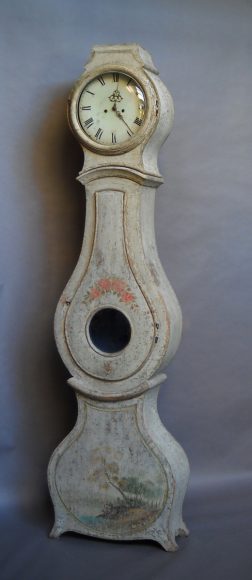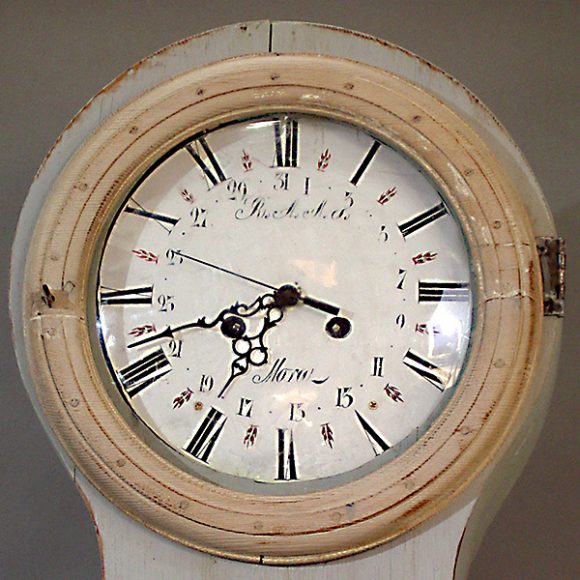+1 413-229-3070 | 800-290-5762 | edithgilson@cupboardsandroses.com
Clocks

When is a Mora clock not a Mora clock?
 If you think this is a trick question, you would be right. Before you can answer the question, you have to decide what you mean when you say “Mora clock.”
If you think this is a trick question, you would be right. Before you can answer the question, you have to decide what you mean when you say “Mora clock.”
Most of the time, for most people, Mora clock = Swedish tall case clock. If you delve a little deeper, you will find that people expect the case to be curvy and painted.
But a clock is more than just a pretty case!
Of course the case is important – after all, it’s 95% of what you see when you look at your clock. The curvy form first appeared in Stockholm in the mid-eighteenth century as an expression of the rococo style that spread north from Paris through Germany and Russia to Stockholm. The new look was intimate, sensitive, and full of graceful S-shaped curves. Colors were lighter – pale grays, creams and pastels with gilding. The style was so livable that it took only 20 years to spread throughout the countryside.
At the same time that the rococo was taking hold in Sweden, years of bad weather and overworked soil in the Mora area led many families from the area around Mora in the Dalarna province to move to the city or to southern Sweden where they learned new crafts. Returning home, they used their new skills to establish a cottage industry –
Making Mora clocks!
[caption id="attachment_5243" align="alignleft" width="185"] Mora clockworks with signed dial[/caption]
Mora clockworks with signed dial[/caption]
Each family specialized in a specific part: some made the brass clockworks; some painted the faces, while others built or painted the cases. At the height of production, more than 90 families were engaged in the trade, and more than 1000 clockworks were produced each year.
When a family some distance away from Mora wanted a clock for their home, they would often buy just the clockworks, weights and pendulum – much easier to transport than the case. Their local cabinetmaker would fashion a case in their own style to house the “Mora” clock.
Is this a true Mora clock?
[caption id="attachment_5244" align="alignright" width="314"] Jämtland clock case carved from single log with blackcock and wheat sheaf carving.[/caption]
Jämtland clock case carved from single log with blackcock and wheat sheaf carving.[/caption]
Technically, it is. But the look might be very different. For instance, cases from the north of Sweden often reference traditional bridal dress with a floral crown and a low belt below the belly of the case with pendant forms reminding one of the keys and decorations a young bride would wear. Another form of northern clock case would be carved from a single log, shaped and smoothed on the outside, with a board applied for the back.
And of course not all Swedish clockworks were made in Mora. There were clockmakers in Stockholm and a early water powered factory which produced clockworks. These were often placed in rococo styled cases. Are these Mora clocks?
The thing about Swedish clocks is that each one is different and has its own quirky charm. With their curves and decoration, they have a decidedly feminine feel – we think of them as our old ladies.
Here at Cupboards & Roses, we search for the most beautiful and unusual Swedish tall case clocks. All our clocks retain their original faces, hands and works. All the surfaces are original paint or, in rare cases, old secondary paint. When a clock is sold, our clockmaker gives it a thorough inspection and adjustment. When properly installed and leveled, they will keep accurate time, warming your home with their hourly chimes.
And we’re happy to call each and every one a Mora clock!